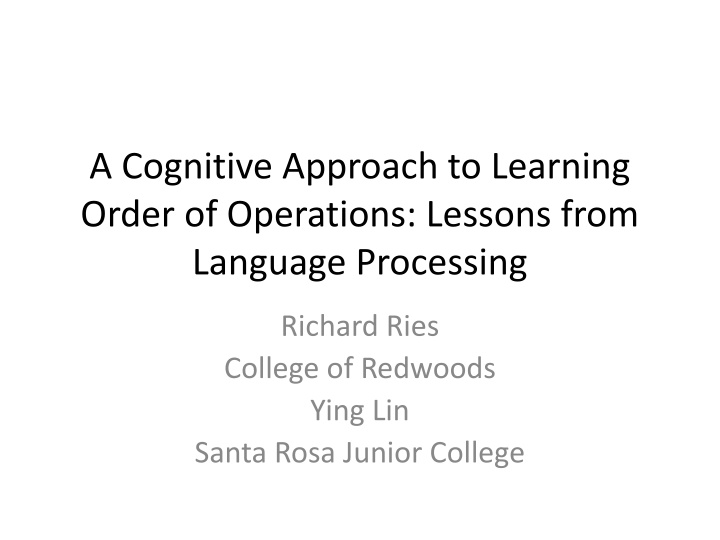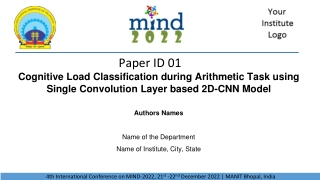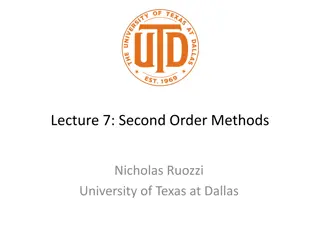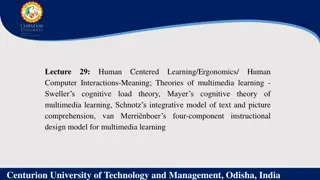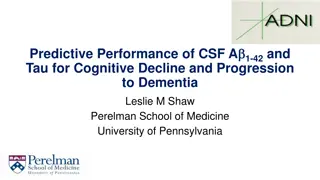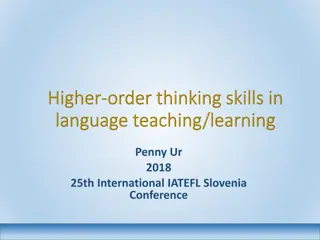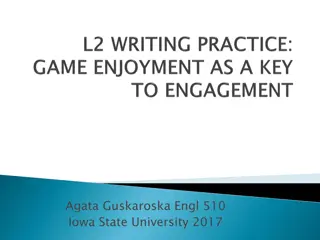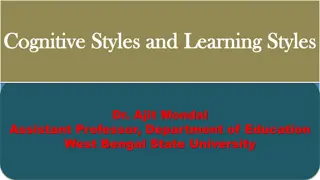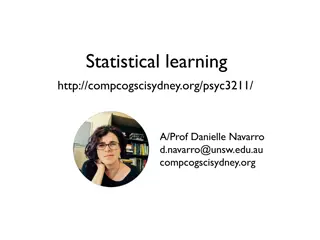Cognitive Approach to Learning Order of Operations: Lessons from Language Processing
This article explores how cognitive approaches can enhance understanding of the order of operations in mathematics by drawing parallels from language processing studies. It discusses the implications for teaching strategies and student learning outcomes, providing valuable insights for educators and learners alike.
Download Presentation

Please find below an Image/Link to download the presentation.
The content on the website is provided AS IS for your information and personal use only. It may not be sold, licensed, or shared on other websites without obtaining consent from the author.If you encounter any issues during the download, it is possible that the publisher has removed the file from their server.
You are allowed to download the files provided on this website for personal or commercial use, subject to the condition that they are used lawfully. All files are the property of their respective owners.
The content on the website is provided AS IS for your information and personal use only. It may not be sold, licensed, or shared on other websites without obtaining consent from the author.
E N D
Presentation Transcript
A Cognitive Approach to Learning Order of Operations: Lessons from Language Processing Richard Ries College of Redwoods Ying Lin Santa Rosa Junior College
Reading and Math Placements in Community Colleges English Tot/FY % placed CSKLS 312 1.84% 109 CSKLS 313 6.55% 388 ENGL 305.1,305X,306X 11.07% 656 ENGL 307,302X,100X 19.23% 1140 Math Assessment ENGL 100 25.83% 1531 ENGL 1A 2103 35.48% Total English 5927 Math CSKLS 371 CSKLS 372 MATH 151 MATH 101/155 MATH 9 MATH 25 MATH 58 MATH 1A Math Total Tot/Fy 1478 883 1373 987 828 95 199 280 6123 % placed 24.14% 14.42% 22.42% 16.12% 13.52% 1.55% 3.25% 4.57% Reading Assessment *Data from SRJC FY 2013-2014
Dear John I want a man who knows what love is all about you are generous kind thoughtful people who are not like you admit to being useless and inferior you have ruined me for other men I yearn for you I have no feelings whatsoever when we re apart I can be forever happy will you let me be yours Amber
Dear John, I want a man who knows what love is all about. You are generous, kind, thoughtful. People who are not like you admit to being useless and inferior. You have ruined me for other men. I yearn for you. I have no feelings whatsoever when we re apart. I can be forever happy -- will you let me be yours? --Amber
Dear John, I want a man who knows what love is. All about you are generous, kind, thoughtful, people, who are not like you. Admit to being useless and inferior. You have ruined me. For other men I yearn. For you I have no feelings whatsoever. When we re apart, I can be forever happy. Will you let me be? Yours, Amber
The red on a teakettle often chips. There, Don ate a kettle of ten chips.
What is 12? Why do so many students think this is 1?
How would we evaluate something like 5 3 12 + 8 4 ? PEMDAS
How would we evaluate something like 5 3 12 + 8 4 ? PMASED PDASME SADMEP etc
Answer the following What is: 2-1= 4-1= 8-7= 15-12=
Subtraction mode? (also known as priming in cognitive psychology)
__________?? ________________ ? ne ____________ pas In my mind this stimulates two questions.
Q1. What are the psychological/cultural/linguistic factors creating these predispositions? Q2. What are the frequencies at which various dispositions govern the interpretive order of operations?
Methodology and Subjects Short quizzes containing the test items (6 each) were administered by instructors 8 Instructors from 3 colleges (Norco, Fullerton, SRJC) participated Includes nearly 1000 students Levels include Arithmetic, Pre-algebra, and Elementary Algebra
Test Items: Effect of Size Facilitative Cues Obstructive Cues Experimental Experimental Control Control
Effect of Size Facilitative Cues Obstructive Cues Experi. Control Experi. Control # Correct # Correct 256 169 133 253 Sample Size Sample Size 447 443 444 454 % Correct % Correct 57.3% 38.1% 30.0% 55.7% P < 0.001 P < 0.001
Effect of Length Test Items Facilitative Cues 12 Experimental Experi. Control # Correct 161 109 12 Control Sample Size 233 227 % Correct 69.1% 48.0% P < 0.001
Effect of Prominence (size, boldness, length combined) Facilitative Cues Obstructive Cues Experi. Control Experi. Control # Correct # Correct 501 322 168 312 Sample Size Sample Size 784 776 548 560 % Correct % Correct 63.9% 41.5% 30.7% 55.7% P < 0.001 P < 0.001
Effect of Spacing Facilitative Cues 12 v.s. 12 Obstructive Cues 5 + 2 4 v.s. 5 + 2 4 Experi. Control Experi. Control # Correct 294 236 # Correct 129 135 Sample Size 430 436 Sample Size 214 218 % Correct 68.4 % 54.1 % % Correct 60.3 % 61.9 % P < 0.001 P = 0.36
Reading as Sentence Processing Each language has a grammar that specifies the syntactic structure of any sentence. Production Rules: [Sentence] [Noun Phrase] [Verb Phrase] [Noun Phrase] [Noun] [Noun Phrase] [Determiner] [Noun] [Verb Phrase] [Verb] [Noun Phrase] [Verb] loves [Noun] John | Mary | dog [Determiner] the
Parsing Algebraic Expressions A grammar that deals with the correct order of operations Expression [Expression] [Expression] + [Term] [Expression] [Expression] [Term] [Expression] [Term] [Term] [Term] [Factor] [Term] [Term] [Factor] [Term] [Factor] [Factor] 1 | 2 | | 9 [Factor] ( [Expression] ) Expression Term Term Term Factor Factor Factor 3 9 6
Parsing Algebraic Expressions An intuitive grammar that produces ambiguous parses for 9 6 3 [Expression] [Expression] [Operator] [Number] [Expression] [Number] [Operator] + | | | [Number] 1 | 2 | | 9
Are the trees real? We don t know. But there is plenty of evidence that people group the words first.
Psycholinguistic Research on Reading (Bever, 1992) A strategy of chunking sentences into phrase units with these cues could be very effective, based purely on memorized features and not on meaning. The same sentence will be easier to read if formatted as: A strategy of chunking sentences into phrase units with these cues could be very effective based purely on memorized features and not on meaning.
How spacing affects reading text Phrase-spaced: Even-spaced:
Main findings regarding Effect of Spacing Cromer (1970): people with good vocabulary and reading disabilities benefit from extra spacing that shows the correct grouping of words. Bever (1991, 1992): Formatting the text with spacing cues improves the comprehension of average readers, but no effect on advanced readers.
Summary of Effect of Phrase-based Spacing Phrase-spaced Control Difference
Summary and Interpretation of Our Results Dev Ed students grouping strategies for algebraic expressions is impacted by presence of cues in the stimuli Such influence parallels the reading research in the past 40+ years Reading and mathematics likely share a deep common mechanism for processing strings of symbols
Implications for the Classroom Should formatting be used to facilitate the learning of order of operations? Esp. for students who are good readers but have genuinely difficulty in reading algebraic expressions Should we be teaching grouping strategies/trees in addition to PEMDAS?
Future Explorations New task / design Measuring speed as well as accuracy. Within-subject design to minimize the effect of test items Automatic formatting of teaching materials Using eye-tracking to identify the rapid eye movements during reading algebraic expressions
Eye Movement Patterns During Reading
References Bever, T. G., Jandreau, S., Burwell, R. , Kaplan, R., & Zaenan, A. (1991). Spacing printed text to isolate major phrases improves readability. Visible Language, 25, 74 87. Cromer, W. (1970). The Difference Model: A New Explanation of Some Reading Difficulties. Journal of Educational Psychology, 61 Jandreau, S., & Bever, T. G. (1992). Phrase-spaced formats improve comprehension in average readers. Journal of Applied Psychology, 77, 143 146. MacGregor, M. & Price, E (1999). An Exploration of Aspects of Language Proficiency and Algebra Learning. Journal for Research in Mathematics Education, 30.4. Shattuck-Hufnagel, S., & Turk, A. E. (1996). A prosody tutorial for investigators of auditory sentence processing. Journal of Psycholinguistic Research, 25(2),
Acknowledge Assistance with data collection: Norco College: Debbie Smith, Joseph DeGuzman, Steven Park, Andy Robles Fullerton College: Mareike Claasen SRJC: Carlos Valencia, Amy Flores
Richard.S.Ries@gmail.com Or ylin@santarosa.edu
Arguments for Linguistic Structure 1) Colorless green ideas sleep furiously 2) Furiously sleep ideas green colorless.
